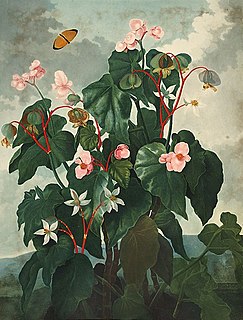
Begonia is a genus of perennial flowering plants in the family Begoniaceae. The genus contains more than 1,800 different plant species. The Begonias are native to moist subtropical and tropical climates. Some species are commonly grown indoors as ornamental houseplants in cooler climates. In cooler climates some species are cultivated outside in summertime for their bright colorful flowers, which have sepals but no petals.
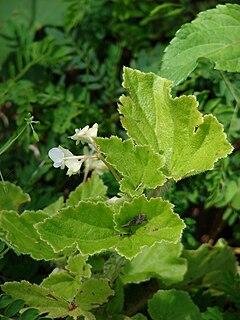
Begoniaceae is a family of flowering plants with two genera and about 1825 species occurring in the subtropics and tropics of both the New World and Old World. All but one of the species are in the genus Begonia. There have been many recent discoveries of species in the genus Begonia, such as Begonia truncatifolia which is endemic to San Vincente, Palawan. B. truncatifolia is smaller in size than other species of the genus Begonia and this new species is proposed Critically Endangered by standards set by the IUCN. The only other genus in the family, Hillebrandia, is endemic to the Hawaiian Islands and has a single species. Phylogenetic work supports Hillebrandia as the sister taxon to the rest of the family. The genus Symbegonia was reduced to a section of Begonia in 2003, as molecular phylogenies had shown it to be derived from within that genus. Members of the genus Begonia are well-known and popular houseplants.
Begonia eiromischa, commonly known as woolly-stalked begonia, is a presumed extinct plant from Malaysia.

Duponchelia fovealis is a species of moth of the family Crambidae described by Philipp Christoph Zeller in 1847. It is endemic to the area surrounding the Mediterranean Sea, and the Canary Islands, but has extended its range to other parts of Africa, Europe, the Middle East and North America.
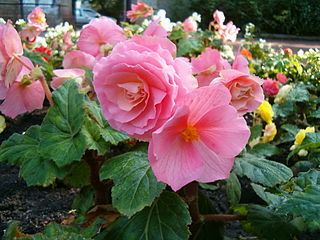
Tuberous begonias are a group of Begonia cultivars, sometimes regarded as some of the most spectacular of the genus.

Begonia boliviensis is a plant in the begonia family, Begoniaceae, which was introduced to Europe in 1864 by Richard Pearce who discovered it in the Bolivian Andes, although the plant had previously been identified by Hugh Weddell in the same region but not introduced.
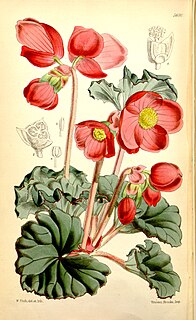
Begonia veitchii is a plant in the begonia family, Begoniaceae, which was introduced to Europe in 1866 by Richard Pearce who discovered it in the Peruvian Andes near Cusco at an elevation of from 10,000 feet (3,000 m) and 12,000 feet (3,700 m). It was named after Pearce's employers, James Veitch & Sons of Chelsea, London. It can be found today in the mountains around Machu Picchu. A later plant collector, Walter Davis, found Begonia veitchii inhabiting rocky positions by waterfalls, in company with Masdevallia veitchiana.
Richard Pearce was a British plant collector, who introduced the tuberous begonia to England, which led to the development of the hybrid begonias grown today.

Begonia masoniana, the iron cross begonia, is a species of plant in the family Begoniaceae, native to southern China and northern Vietnam. It was originally described from cultivated plants of unknown origin and was only much later rediscovered in the wild. It is a rhizomatous perennial begonia growing to 0.5 metres (20 in), bearing large, asymmetrical, textured green leaves covered in reddish hairs, with a prominent dark brown pattern in the centre of each leaf, reminiscent of the German Iron Cross. It produces small white flowers in erect panicles, but is cultivated mainly for its foliage effect. In temperate regions it must be grown under glass, or in a completely frost-free environment. Although sometimes (incorrectly) considered a rex begonia, this species is classified in the related section Coelocentrum.
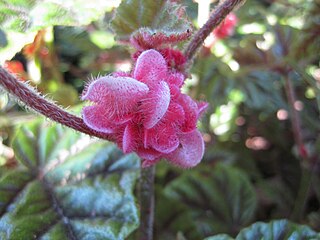
Begonia incarnata is a species of plant in the family Begoniaceae, native to Brazil. It is a shrublike evergreen perennial growing to 1 metre (39 in), bearing large, asymmetrical green leaves with a metallic sheen, and dark green veins. It produces small hairy pink flowers. As it does not tolerate temperatures below 10 °C (50 °F), in temperate regions it must be grown under glass.

Begonia cubensis, also known as Cuban holly, is a species of perennial plant that belongs to the Begoniaceae. It is native to Cuba and its habit is an understory shrub. Its habitat range is from moist subtropical to tropical climates.

Begonia cucullata, also known as wax begonia and clubed begonia, is a species of the Begoniaceae that is native to South American countries of Argentina, Brazil, Paraguay, and Uruguay. A common garden plant and part of the section Begonia, it was described in 1805 by Carl Ludwig Willdenow (1765–1812). The specific epithet "cucullata" means "resembling a hood" or "hooded".
Begonia beijnenii is a species of flowering plant in the family Begoniaceae, native to the island of Palawan in the Philippines.
Begonia cabanillasii is a species of flowering plant in the family Begoniaceae, native to the island of Palawan in the Philippines.
The Philippine Taxonomic Initiative (PTI) is a private Philippine research institute and non-profit organization located in Palawan.
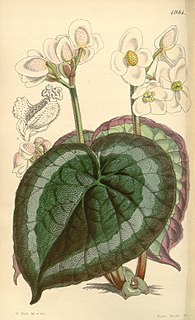
Begonia annulata, the ringed begonia, is a species of flowering plant in the genus Begonia native to the eastern Himalaya, Bangladesh, Assam in India, Myanmar, and Vietnam. It has gained the Royal Horticultural Society's Award of Garden Merit.
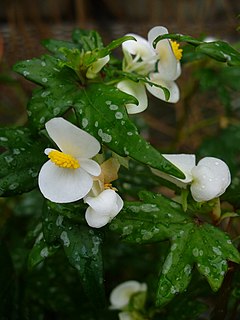
Begonia dregei, the maple leaf begonia or grape-leaf begonia, is a species of flowering plant in the genus Begonia native to South Africa. It has gained the Royal Horticultural Society's Award of Garden Merit.

Begonia luxurians, the palm leaf begonia, is a species of flowering plant in the genus Begonia, native to southeastern Brazil. It has gained the Royal Horticultural Society's Award of Garden Merit.

Begonia radicans, the shrimp begonia, is a species of flowering plant in the genus Begonia, native to southeastern and southern Brazil. It has gained the Royal Horticultural Society's Award of Garden Merit.














